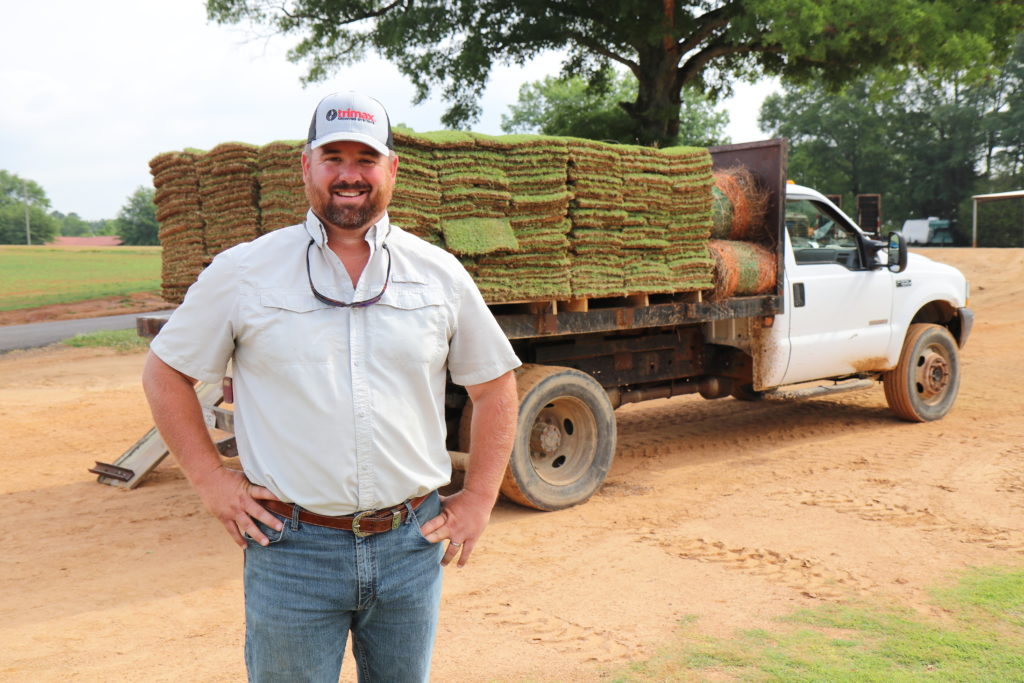Self-Stacking Sod Harvester A Game-Changer

By Marlee Moore
The first time Matt Smith saw an automated sod harvester demonstrated on his Dixie Sod Farm, he believed it could never stack up to his then-familiar system — one man in the cab, two on the back loading pallets.
“I said, ‘We’ll be hand-stacking forever,’” he remembered, noting how the rough mechanism tore the sod as it stacked, reducing quality.

Fast forward to 2021, and an automated bright-blue FireFly ProSlab 155B cuts a sharp figure across Smith’s third-generation farm in Pell City east of Birmingham.
The new harvester, a different brand from the years-ago demo, simultaneously cuts and neatly stacks sod with just one operator. It’s an essential advancement in technology that reduces inputs while delivering symmetrical slabs of sod with limited damage.
That’s critical when labor is hard to find. The summer Smith invested in the FireFly, it was rare to have workers who lasted more than a few days manually moving sod in the blistering Alabama heat.
“Sure, you can cut labor, but that’s not a selling point for me,” said Smith, 39. “Now, instead of guys hanging on the back of a machine stacking sod on pallets, they’re working somewhere else on the farm. My dad’s rule of thumb was one man per 40 acres of grass. With new equipment, we need one man for 75-80 acres.”
Today, an operator climbs into the cab and hits the fields armed with a joystick and keypad. The cutter slides under the grass while chopping slabs every 24 inches. The cutting mechanism feeds sod onto a conveyor, positioning turf for stacking. A simple hook system driven by electric servo motors places the sod on pallets, completing a 450-square-foot pallet in just over two minutes.
The automated harvester allows Smith to devote manpower to other tasks — patrolling fields for rogue grasses, mowing, spraying and loading trailers.
Although the machine takes the place of two workers, Smith admits there’s a downside — inevitable breakdowns take a different skill set to repair than old machines because of computerized, advanced technology. But FireFly’s top-notch support team (one of the best Smith said he’s worked with) relieves the pressure.
It’s just one example of how technology is revolutionizing the sod industry, Smith said. Automated irrigation delivers timely moisture to Smith’s acreage, pushing the red clay to increase production. In the past, Smith would sleep in the edge of a field with his truck positioned so water would hit his windshield at the end of a rotation, alerting to change the sprinklers.
“Now I can pick up my phone and start and stop pivots,” said Smith, who serves on the Alabama Farmers Federation State Greenhouse, Nursery & Sod Committee.
At 13, Smith started learning the ropes from his father, Richard Smith, who was taught by his father-in-law, Marlin Hugghins. Previous generations valued technology, too, bringing one of the first tractor-mounted sod harvesters into the U.S. from Canada.
Smith is intentional about serving small buyers in Alabama — weekend warriors, folks seeking small stacks of sod and landscapers. That includes Jeff Martin of Landscapes by Shelly in Pell City.
Dixie Sod provides most of their turf, thanks to Smith’s personal touch and quality product.
“The quality of grass is second to none — always,” Martin said. “And if there’s a problem, Matt is Johnny on the spot. We’ll wait to get his grass.”
Other farmers are catching on to the FireFly craze as harvesters cut swaths across Alabama fields. It’s revolutionary for the fourth-largest sod-producing state in the U.S., said Hunter McBrayer, the Federation’s past Greenhouse, Nursery & Sod Division director.
“Many Alabamians miss that most turfgrass in parks, businesses or even in their home lawn may have come from right up the road,” McBrayer said. “Alabama has a booming sod industry, and we are excited to see what the future holds for our producers.”
